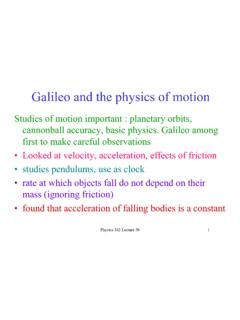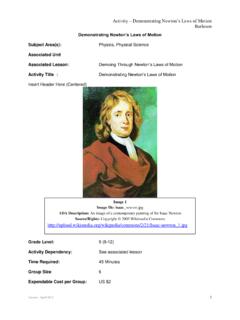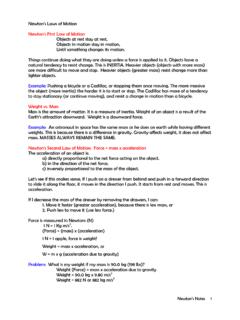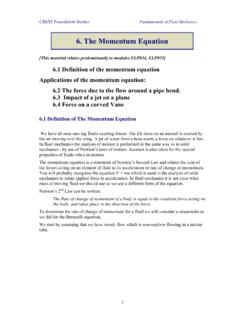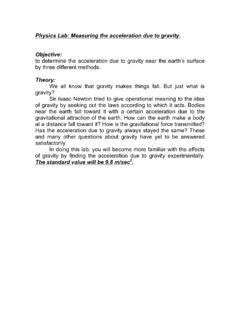Transcription of *ANSWER KEY * ANSWER KEY* ANSWER KEY* Newton's …
1 * ANSWER KEY * ANSWER KEY* ANSWER KEY* Newton's First Law of motion Study Guide Newton's First Law of motion (Law of Inertia) An object at rest will remain at rest unless acted on by an unbalanced force. An object in motion continues to move with the same velocity unless acted on by an unbalanced force. 1. In your own words, paraphrase the first part of Newton's First Law of motion . (An object at rest will remain at rest unless acted on by an unbalanced force). This part of Newton's First Law states that an object that has a speed of 0 m/s, will not move and will remain at rest unless there is an unbalanced force that pushes on the object and cause it to move. 2. List two examples of objects around you that are not moving right now.
2 The science book resting on that table is not moving. A poster is taped to the door and is not moving. It is at rest. 3. Newton's First Law of motion is also known as the Law of Inertia. Inertia is the tendency of an object to resist a change in motion . What is the relationship between an object's mass and its inertia? An object that has more mass will have more inertia or resistance to a change in motion . For example, more force is needed to move a 100 kilogram object that is at rest compared to the small amount of force needed to move a 5 kilogram object. 4. An unbalanced force can cause an object at rest to move. Give two real life examples of when a non-moving object starts moving. If a science book is on a table and is not moving, the force of my hand lifting it up will provide the unbalanced force needed to move it.
3 In another example, if a very strong wind blows, it can cause the poster on the door to detach and fall to the ground. 5. Watch this coin drop demonstration and explain what happens to the coin using Newton's First Law of motion . The penny is not moving. When you quickly remove the index card, the penny will fall down into the cup because of the unbalanced force of Earth's gravity . 6. In your own words, paraphrase the second part of Newton's First Law of motion . (An object in motion continues to move with the same velocity unless acted on by an unbalanced force.) The second part of Newton's First Law of motion states that an object that is moving at a constant velocity, meaning the same speed and in the same direction, will continue to move at this same velocity unless and unbalanced force acts on the object.
4 7. Give two examples of an object changing its velocity (accelerated motion ). A car is moving at the same speed because it is on cruise control. When the driver presses on the pedal, the speed of the car increases so the velocity changes. In another example, a parachutist falls down towards the earth at the same speed. However, when he opens up his parachute, the wind will push up and cause a change in his velocity. 8. Draw two pictures that explain how these two pictures summarize Newton's First Law of motion . Object at rest Object moving at constant velocity. * ANSWER KEY * ANSWER KEY * ANSWER KEY* Newton's Second Law of motion (F=ma) Study Guide 1. A skateboard has a mass of 3 kg and accelerates at a rate of 5 m/s2.
5 Find the amount of unbalanced force. F= ma F= 3 kg (5 m/s/s) F= 15 N 2. If a force of 4 N moves a paper airplane with an acceleration rate equal to 8 m/s/s, what was its mass? M= F/A M= 4 N/ 8 m/s/s M= kg 3. If a 2 kg paper airplane is pushed by the wind with a force of 5N, how fast will the paper airplane accelerate? A= F/M A= 5N/ 2 kg A= m/s/s 4. A bird has a mass of 6 kg and accelerates at a rate of 7 m/s2. Find the net force. F= ma F= 6 kg (7 m/s/s) F= 42 N 5. If an object s mass is 65 kg and it accelerates at a rate of 2 m/s/s, how much force was applied? F= ma F= 65 kg (2 m/s/s) F= 130 N 6. Find the force of a 240 kg vehicle accelerating at a rate of m/s/s when it hits the wall. F= ma F= 240 kg ( m/s/s) F= 1080 N 7.
6 Find the acceleration rate if the force is 200 N and the mass of an object is 150 kg. A= F/M A= 200 N/ 150 kg A= m/s/s 8. What is the acceleration rate if the force is 170 N and the object's mass is 25 kg? A= F/M A= 170 N/ 25 kg A= m/s/s 9. What amount of unbalanced force is needed to accelerate a 10 kg crate of strawberries at a rate of m/s/s? F= ma F= 10 kg ( m/s/s) F= 35 N 10. Find the mass of a golf cart that is accelerating at a rate of 6 m/s/s and has a force of 342 N. M= F/A M= 342 N/ 6 m/s/s M= 57 kg 11. A truck has a mass of 5000 kg. The truck driver presses on the brakes. The unbalanced net force acting on the truck when the brakes were applied was 6000 N. What is the truck's acceleration?
7 A= F/M A= 6000 N/ 5000 kg A= m/s/s 12. Find the mass of the object if the force acting on it was 300 N and the acceleration rate was m/s/s. M= F/A M= 300 N/ m/s/s M= m/s/s 13. What is the force needed to accelerate a 144 kg cart at a rate of m/s/s? F= ma F= 144 kg ( m/s/s) F= 360 N 14. The cyclist has a mass of 50 kg and is accelerating at m/s2. What is the amount of the net unbalanced force? F= ma F= 50kg ( m/s/s) F= 45 N 15. What is the mass of the object if the net force acting on it was 356 N and the acceleration rate was 4 m/s/s? M= F/A M= 356 N/ 4 m/s/s M= 89 kg 16. Two forces act on a parachutist during a drop. Net force is 550 N. The parachutist has a mass of 100 kg. What is the acceleration of parachutist?
8 A= F/M A= 550 N/ 100 kg A= m/s/s 17. The car has an acceleration of 7 m/s2 and a mass of kg. What is the size of the force? F= ma F= ( kg) (7 m/s/s) F= N 18. A car is pulled with a force of 10,500 Newtons. The car's acceleration rate is 2 m/s/s. What is the mass of the car? M= F/A M= 10,500 N/ 2 m/s/s M= 5,250 kg 19. An unbalanced force of 48 Newtons is applied to an object with a mass of 12 kg. What is its acceleration rate? A= F/M A= 48 N/ 12 kg A= 4 m/s/s 20. A toy is moving at a rate of m/s/s. The mass of the toy is kg. What is the amount of force used to move that toy? F= ma F= ( kg)( m/s/s) F= N 21. What is the relationship between mass and force? If the mass of an object increases, then the amount of net force needed to move that object at the same acceleration rate will also need to increase.
9 There is a direct correlation between mass and force. 22. What is the relationship between force and the acceleration rate? If the amount of force acting on an object increases, then the object will accelerate at a greater rate. There is a direct relationship between mass and force. * ANSWER KEY * ANSWER KEY * ANSWER KEY Newton's Third Law of motion Study Guide Newton's Third Law of motion states that for every action, there is an equal and opposite reaction. In other words, when two objects interact, they are a pair of forces. One object exerts and action force while the other object exerts a reaction force. The magnitude of the action force is equal to the magnitude of the reaction force while the direction of the action force is opposite to the direction of the reaction force.
10 Part A: ANSWER the questions below about Newton's Third Law of motion . 1. Newton's Third Law states that when two objects interact, there is a pair of forces. What is this pair of force called? The pair of forces is called action force and reaction force. 2. The magnitude of the action force is the same as the magnitude of the reaction force. The direction of the action force acts is in the opposite direction as the reaction force. 3. A bat is hitting a baseball. The action force is the baseball hitting the bat to the left. What is the reaction force? The reaction force is the bat hitting the baseball with the same magnitude but in the opposite direction. 4. A bowling ball hits a pin. The action force is the bowling ball hitting the pin to the right.
